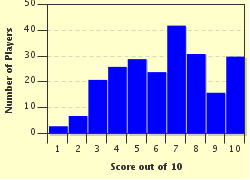Quiz Answer Key and Fun Facts
1. Which of these best describes the process of nuclear fission?
2. Not all atoms can undergo nuclear fission. Which of these terms is used to describe an atom that can do so spontaneously?
3. Very few atoms can undergo spontaneous fission. Most times, however, the process of nuclear fission follows which of these events?
4. A particular atom is often described by writing a number after the name of the element. This number is called the mass number, and tells us which of the following pieces of information about this atom?
5. Which of these atoms is commonly used in man-made nuclear fission reactions?
6. When the nucleus of an atom of uranium-235 absorbs a neutron, it becomes an atom of uranium-236, and then breaks into two smaller atoms, such as krypton-92 and barium-141. This second reaction also produces how many neutrons?
7. Because the fission of a nucleus typically releases neutrons, these neutrons can collide with other nearby nuclei, and cause them to undergo fission. What is the term for this process?
8. What is the term that describes the minimum amount of a substance that must be present before a sustained nuclear fission reaction can occur?
9. One way of making atoms more likely to undergo fission is to slow down the free neutrons that have been produced, and make them more likely to be absorbed by nearby nuclei. What is the term used to describe substances used to slow neutrons down?
10. Which of the following is NOT a way in which nuclear fission is useful?
Source: Author
looney_tunes
This quiz was reviewed by FunTrivia editor
NatalieW before going online.
Any errors found in FunTrivia content are routinely corrected through our feedback system.


